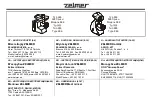
11
English
4. Filter cleaning and inspection
WARNING
Wear protective glasses and a dust mask when cleaning
the
fi
lter with an air gun.
Failure to do so may result in inhalation or exposure of
the eyes to debris or dust.
After use, remove any debris or dust adhered to the
fi
lter
using a soft brush. (
Fig. 12
) Check the
fi
lter periodically
to ensure that it is free of scratching, chipping, or tearing.
Replace with a new
fi
lter if the
fi
lter is damaged in any way.
NOTE
If the mesh is clogged and the debris or dust cannot be
removed, detach the
fi
lter and clean it with an air gun,
etc. (See “Exchanging the
fi
lter set (
Fig. 13
)”)
5. Exchanging the
fi
lter set (Fig. 13)
NOTE
○
When detaching the
fi
lter, be careful not to let debris
enter the tool body.
○
Leave the
fi
lter set attached to the body, except when
cleaning or exchanging the
fi
lter set.
6. Maintenance of the motor
The motor unit winding is the very “heart” of the power tool.
Exercise due care to ensure the winding does not become
damaged and/or wet with oil or water.
NOTE
In order to expel debris and dust, periodically run the
motor with no load.
7. Cleaning on the outside
When the power tool is stained, wipe with a soft dry cloth
or a cloth moistened with soapy water. Do not use chloric
solvents, gasoline or paint thinner, for they melt plastics.
8. Storage
Store the power tool in a place in which the temperature
is less than 40°C and out of reach of children.
CAUTION
In the operation and maintenance of power tools, the
safety regulations and standards prescribed in each
country must be observed.
GUARANTEE
We guarantee HiKOKI Power Tools in accordance with
statutory/country speci
fi
c regulation. This guarantee does
not cover defects or damage due to misuse, abuse, or
normal wear and tear. In case of complaint, please send
the Power Tool, undismantled, with the GUARANTEE
CERTIFICATE found at the end of this Handling instruction,
to a HiKOKI Authorized Service Center.
IMPORTANT
Correct connection of the plug
The wires of the main lead are coloured in accordance
with the following code:
Blue: — Neutral
Brown: — Live
As the colours of the wires in the main lead of this tool may
not correspond with the coloured markings identifying the
terminals in your plug proceed as follows:
The wire coloured blue must be connected to the terminal
marked with the letter N or coloured black. The wire
coloured brown must be connected to the terminal marked
with the letter L or coloured red. Neither core must be
connected to the earth terminal.
NOTE:
This requirement is provided according to BRITISH
STANDARD 2769: 1984.
Therefore, the letter code and colour code may not be
applicable to other markets except The United Kingdom.
Information concerning airborne noise and vibration
The measured values were determined according to
EN62841 and declared in accordance with ISO 4871.
Measured A-weighted sound power level: 95 dB (A)
Measured A-weighted sound pressure level: 87 dB (A)
Uncertainty K: 3 dB (A).
Wear hearing protection.
Vibration total values (triax vector sum) determined
according to EN62841.
Surface grinding:
Vibration emission value
a
h, AG
= 5.3 m/s
2
Uncertainty K = 1.5 m/s
2
Cutting o
ff
:
Vibration emission value
a
h, CO
= 5.4 m/s
2
Uncertainty K = 1.5 m/s
2
The declared vibration total value and the declared noise
emission value have been measured in accordance with a
standard test method and may be used for comparing one
tool with another.
They may also be used in a preliminary assessment of
exposure.
WARNING
○
The vibration and noise emission during actual use
of the power tool can di
ff
er from the declared total
value depending on the ways in which the tool is used
especially what kind of workpiece is processed; and
○
Identify safety measures to protect the operator that
are based on an estimation of exposure in the actual
conditions of use (taking account of all parts of the
operating cycle such as the times when the tool is
switched o
ff
and when it is running idle in addition to the
trigger time).
○
The grinding thin sheets of metal or other easily vibrating
structures with a large surface can result in a total
emission much higher (up to 15 dB) than the declared
noise emission values.
Such workpieces should as far as possible be prevented
from emitting sound by suitable measures such as the
application of heavy
fl
exible damping mats.
The increased noise emission is also to be considered
for both the risk assessment of noise exposure and
selecting adequate heating protection.
NOTE
Due to HiKOKI’s continuing program of research and
development, the speci
fi
cations herein are subject to
change without prior notice.
00Book̲G13VE2.indb 11
00Book̲G13VE2.indb 11
2022/07/29 18:12:26
2022/07/29 18:12:26
Summary of Contents for G 13VE2
Page 2: ...2 1 2 3 4 00Book G13VE2 indb 2 00Book G13VE2 indb 2 2022 07 29 18 12 19 2022 07 29 18 12 19...
Page 178: ...178 00Book G13VE2 indb 178 00Book G13VE2 indb 178 2022 07 29 18 13 20 2022 07 29 18 13 20...
Page 180: ...180 00Book G13VE2 indb 180 00Book G13VE2 indb 180 2022 07 29 18 13 23 2022 07 29 18 13 23...












































